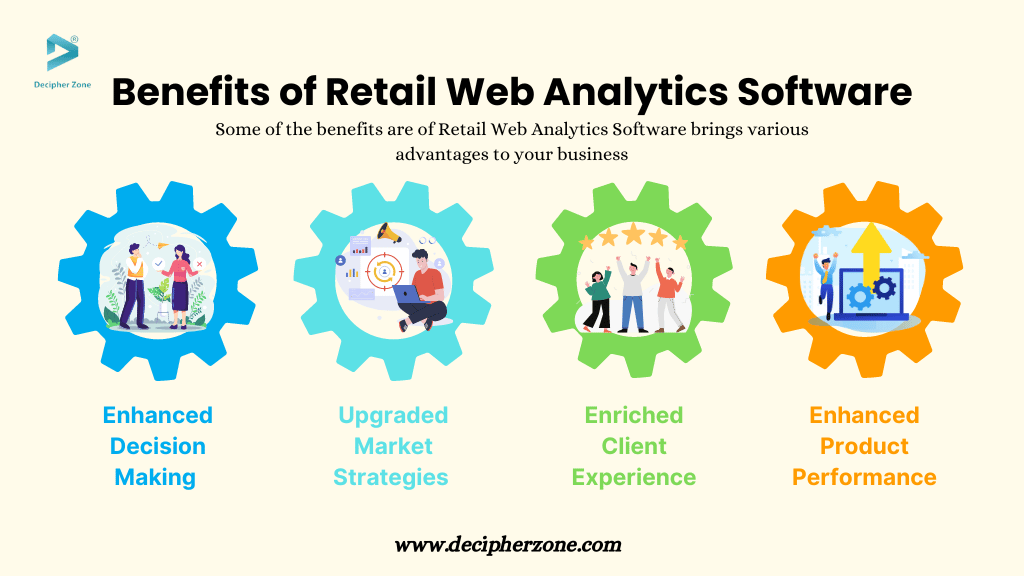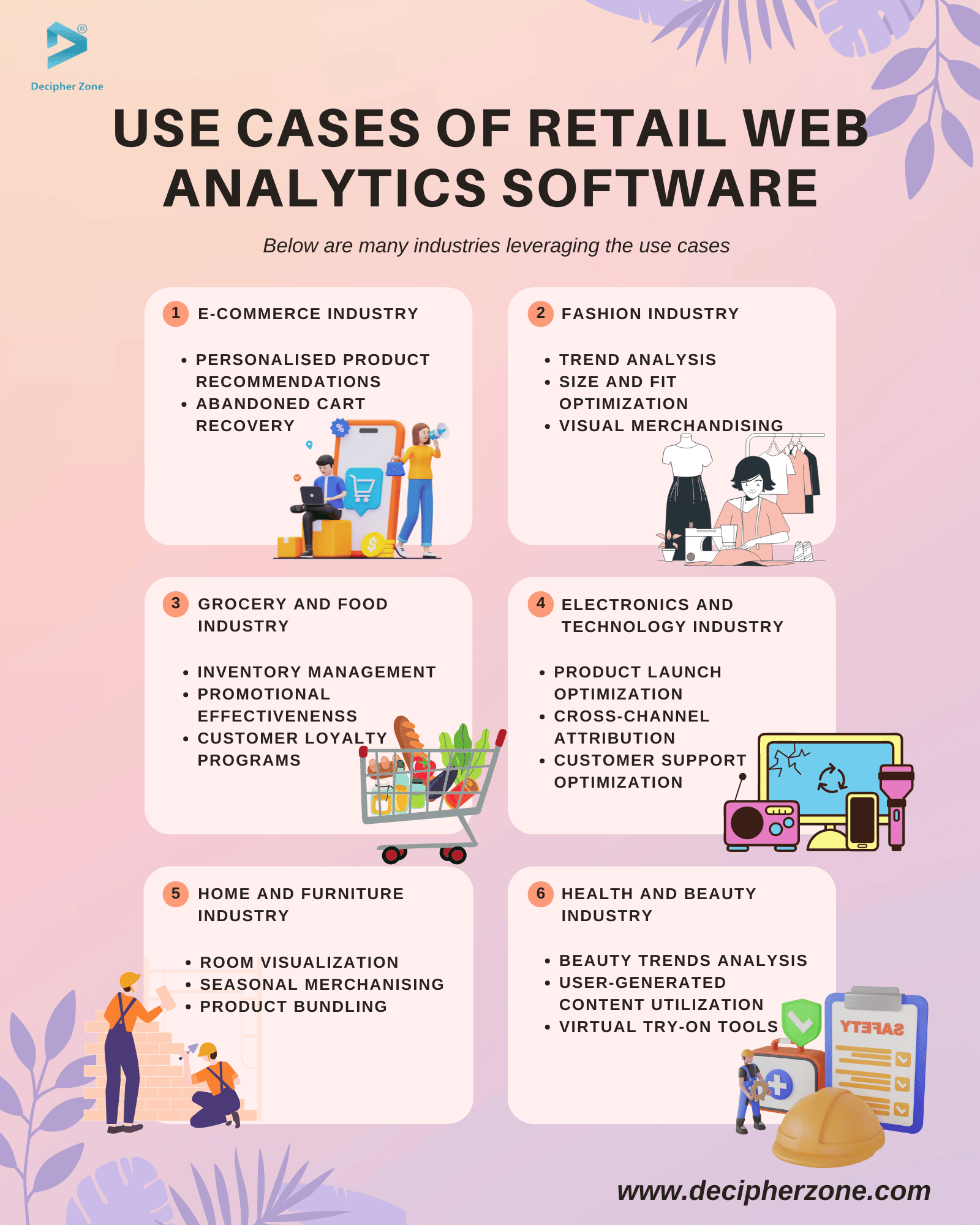Retail web analytics software is a valuable tool for businesses to monitor and analyze various aspects of their performance and user behaviour. In this blog, we will explore the different types, and advantages, and highlight some popular tools, use cases, future trends, and steps involved in developing such software. Keep reading to gain a comprehensive understanding of retail web analytics software.
Businesses currently make up 80% of all retail activity, highlighting the crucial role of retailers in shaping the customer experience. Market analysis projects robust growth in the Retail Industry, with an expected expansion at a CAGR of 7.65% from $32.68 trillion in 2024 to $47.24 trillion by 2029.
Despite the surging e-commerce trend, the number of retail stores is on the rise, underscoring their continued relevance in driving the economy. Moreover, stores are evolving to cater to purchases made through various channels, demonstrating adaptability and resilience in an ever-changing market.
Read: Fashion and Luxury Software Solutions
What is Web Analytics Software?
Web Analytics Software enables the comprehensive tracking, measurement, and analysis of various elements of website performance and user behaviour. This tool empowers website owners, marketers, and analysts to accumulate valuable insights on user engagement, facilitating data-driven decisions to enhance user experience, refine marketing approaches, and attain business goals.
Benefits of Retail Web Analytics Software Development
Retail Web Analytics Software brings various advantages to your business by evaluating the data, enriching the aspects of operations and driving growth. Some of the benefits are:

-
Enhanced Decision Making
Retail web analytics software provides substantial insights into consumer behaviour, market trends, and product performance which delegates the decision-making power. Businesses can tailor strategies to target the audience by understanding the client preferences, purchasing patterns, and demographics.
-
Upgraded Market Strategies
Retail web analytics software enables the efficient allocation of resources by aiding in understanding marketing campaigns across various platforms. This assists businesses in boosting sales by tracking conversion rates, click-through rates, and consumer engagement.
-
Enriched Client Experience
Understanding customer behaviour and preferences allows you to personalize the shopping experience and improve customer satisfaction. By using customer feedback, you can identify areas for improvement that enhance the customer experience.
-
Enhanced Product Performance
Web analytics provide valuable insights into product performance metrics, including sales trends, customer reviews, and inventory turnover rates. Businesses can leverage this data to identify successful products, as well as to enhance product management and development processes.
-
Improved Inventory Management
Leveraging web analytics empowers businesses to predict demand, monitor inventory levels, and optimise stock-refilling processes. This results in minimising stockouts, reducing excess inventory, ensuring timely availability of products, and lowering costs.
Types of Retail Web Analytics
Retail analytics is the process of gathering useful information on sales, demand from customers, inventory levels, supply chain movement, and various other issues. They may all be used for a range of tasks, such as deciding on marketing strategies and keeping procurement levels stable. Some of the types of retail web analytics are as follows:
-
Descriptive Retail Web Analytics
This provides insightful analysis of historical performance by gathering raw data from a variety of sources, including Google Analytics, POS terminals, inventory systems, OMSs, and ERPs. It may also assist in detecting previous issues in an organization.
-
Predictive Retail Web Analytics
Retailers use predictive analytics to forecast product demand, manage inventory, optimize pricing, and create personalized marketing strategies. They can anticipate customer behaviour, purchase trends, and preferences, and predict which customers are likely to leave, as well as which products will be popular.
-
Social Media Retail Web Analytics
This type involves monitoring metrics including engagement, reach, followers, brand beliefs, and social media conversations, allowing retailers to respond to consumer inquiries, and focusing on tracking and analysing the performance of retailers on social media platforms.
Read: SaaS App Development
-
Prescriptive Retail Web Analytics
Prescriptive analytics provides recommendations for improving business performance based on predicted outcomes. It helps determine pricing strategy, inventory management, logistics, marketing campaigns, staffing, and investment opportunities. Using optimization techniques, simulation models, and machine learning algorithms, it presents potential solutions ranked by performance to aid decision-making and improve operations.
-
Diagnostic Retail Web Analytics
Web analytics uses past data to understand why things happened. It uses statistical analysis, algorithms, and machine learning to find correlations in the data. It's valuable for identifying anomalies and issues in retail, such as technical errors on e-commerce websites. Larger retailers use machine learning and AI for diagnostic analytics to minimize human error.
Retail Web Analytics Tools
There are wide range of retail web analytics tools that help businesses acquire customer data insights including:
-
Point of Sale System (POS)- A point of sale (POS) system is a tool used by retailers to manage sale transactions and in-store inventory, for example, a cash register.
-
Foot Traffic Counter- This tool counts the number of people visiting a store. It can be done manually using counters or digitally using cameras and retail tracking software.
-
Inventory Analytics- With the use of monitoring metric approaches, this tool optimizes inventory management so that businesses can fulfil consumer demand while keeping expenses to a minimum.
-
Email Analytics- This tool involves collecting, analyzing, and reporting on data related to email marketing. It helps retailers gain insights into the performance of their email campaigns and make data-driven decisions about their communication strategy.
-
Business intelligence tools- Retailers use BI tools to analyze large volumes of data and track key performance indicators such as customer loyalty, inventory turns, sell-through rate, and days on hand. This information can be used to generate reports for executives and other decision-makers.
-
Predictive analytics- This tool uses past data to predict future trends and behaviours in retail. Its four common types are descriptive, diagnostic, predictive, and prescriptive, used to find growth opportunities and new customer segments.
Use Cases of Retail Web Analytics Software
You may be curious about the various applications of retail web analytics software. Below is an image illustrating the different use cases.

Future Trends in Retail Web Analytics
Businesses can achieve sustainable growth in the retail industry by embracing and leveraging the right future trends in web analytics. Here are some of the future trends:
-
AI and ML Integration
Artificial Intelligence (AI) and Machine Learning (ML) will revolutionize predictive analysis, providing businesses with more accurate forecasts for customer demand, behaviour, sales trends, and inventory. Moreover, AI chatbots and virtual assistants have the capability to deliver tailored customer support, offer product recommendations, and provide shopping assistance, ultimately enhancing the overall customer experience.
Read: Kiosk Software Development
-
Ethical Data Usage and Sustainability Analytics
It will be easier for businesses to measure and analyze sustainability initiatives, including carbon footprint, waste reduction, and ethical sourcing practices. This will allow retailers to communicate their environmental impact to customers. Moreover, retailers will ensure that customer data is collected, stored, and used responsibly by prioritizing transparent and ethical data practices.
-
Omni Channel Analytics
By using comprehensive omni-channel analytics, merchants can customize their marketing strategies and understand the impact of each sales channel by gathering information from various touchpoints. Integrated systems also allow businesses to create a unified view of the consumer experience across all channels, both online and offline, leading to improved interactions and personalized experiences.
-
Refined Customer Segmentation
Creating dynamic customer profiles enables retailers to integrate and analyze retail data that evolves based on ongoing interactions. This allows for more precise targeting and customized experiences. In addition, retailers can use customer segmentation techniques to develop marketing campaigns for specific customer segments.
-
NLP and Voice Commerce
Natural Language Processing (NLP) algorithms help in attaining deep insights from customer feedback, social media mentions, and support interactions to dive into customer sentiment, preferences, and reviews for a competitive edge. With the surge in virtual assistants, gear up your website for voice search and voice-activated shopping experiences to stay ahead in the voice commerce game.
Read: Data Analytics Software Development
Conclusion
Embrace the power of retail web analytics to enhance customer experiences, streamline operations, and achieve sustainable growth. Retail web analytics software offers numerous advantages that can significantly enhance business operations and decision-making. The proficient developers at Decipher Zone can help businesses develop robust retail web analytics software tailored to their specific needs, ensuring they gain valuable insights and optimize their strategies.
FAQs
-
What is retail data analytics?
Retail analytics is the process of gathering useful information on sales, demand from customers, inventory levels, supply chain movement, and various other issues. They may all be used for a range of tasks, such as deciding on marketing strategies and keeping procurement levels stable.
-
What is the most popular web analytics tool?
There are wide range of retail web analytics tools that help businesses acquire customer data insights including Point of Sale System (POS), Foot Traffic Counter, Inventory Analytics, Email Analytics, Business intelligence tools, and more.
-
What are the two main types of retail web analytics?
There are two main types of retail web analytics: Descriptive Retail Web Analytics and Diagnostic Retail Web Analytics.
-
What are the future trends in retail web analytics?
Businesses can achieve sustainable growth in the retail industry by embracing and leveraging the right future trends in web analytics. Some of the future trends are AI and ML Integration, Ethical Data Usage and Sustainability Analytics, Omni Channel Analytics, Refined Customer Segmentation, and NLP and Voice Commerce.

